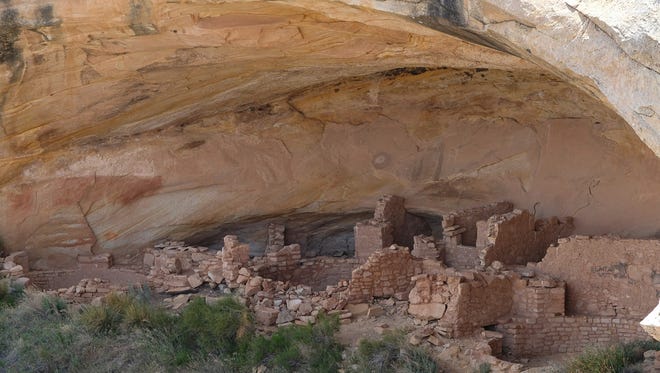Bears Ears monument gets visit from Interior secretary

BLANDING, Utah — Interior Secretary Ryan Zinke described himself as a Teddy Roosevelt Republican as he stood Monday on the edge of the Butler Wash overlook trail in Bears Ears National Monument.
As a Teddy Roosevelt Republican — Roosevelt signed the Antiquities Act of 1906 and used it to create 18 national monuments by presidential proclamation — and a Montanan, Zinke said public lands are an important issue for him.
An April 26 executive order from President Trump prompted Zinke's visit. It asked the Interior Department's secretary to review all national monuments larger the 100,000 acres and designated since 1996 using the Antiquities Act.
The order includes a number of monuments in the Southwest, including Canyons of the Ancients in the Four Corners area and Grand Canyon Parashant in Arizona.
► Saturday:27 national monuments under Interior Department review
But at almost 1.4 million acres, Bears Ears National Monument has become a flash point in the federal land debate and was on the top of Zinke's list. In December, President Obama designated the region, named for two prominent buttes that resemble bears' ears, as a national monument.
While flying over the monument on a media tour Monday morning, Tim Peterson, Utah Wildlands program director for the Grand Canyon Trust nonprofit conservation and advocacy group, said all five tribes have the same Bears Ears name for the formation.

"It really has everything that the Antiquities Act was meant to protect," Peterson said.
However, some who aren't Native American have called use of the Antiquities Act to create the monument a form of government overreach.
Utah's Republican governor, Gary Herbert, said the Bears Ears National Monument as well as the Grand Staircase-Escalante National Monument in south-central Utah near Kanab, have been controversial. He said some residents near Grand Staircase-Escalante still feel bitter about its designation in 1996 when Democrat Bill Clinton was president and about its size of almost 1.9 million acres.
Zinke visits Grand Staircase-Escalante on Tuesday.
Those same bitter sentiments are being echoed in southeastern Utah. As Chairman Bruce Adams of the San Juan County Commission waited for Zinke's arrival outside Blanding airport, the Republican wore a baseball hat with echoing Trump's campaign slogan, "Make San Juan County Great Again."
Obama's designation of Bears Ears, which Adams said could negatively affect the county's oil, gas and other extraction-related industries, was a roadblock to that economic development.
Utah's Speaker of the House, GOP Rep. Greg Hughes of Draper, said Zinke's visit provides the area's small communities with an opportunity for dialogue. Hughes said he met Sunday at the state capitol with Zinke and had dinner with him.
One side of the argument is the concern that the national monument will restrict access to more than 1.3 million acres of land in southeastern Utah, Hughes said.
► April 26:24 national monuments threatened by Trump's executive order
► April 25:Amid public land battle, outdoor industry boasts $887 billion impact
On the other side is a "strong desire and I think a noble goal to be good stewards of the land," he said.
Thousands of archaeological sites within the monument's boundaries and the sacred landscape have been looted and vandalized and need to be protected, said President Kenneth Maryboy of the Mexican Water, Utah, Navajo chapter and a Democrat who used to be on the San Juan County Commission.

Zinke said a lot the anger across the USA is happening because people feel that policymakers aren't hearing their voices..
"We're the collaborative department," he said of the Interior Department. "We want to work with local communities. We want to solve problems rather than create them. We want to be advocates rather than adversary.
"When you see a BLM (Bureau of Land Management) truck out there, I want to make sure that the public views that BLM truck as a land manager, someone to be respected," Zinke said. "When they see a park ranger, I want to make sure their kids look up and say, 'You know what, I want to be a park ranger.' You know a lot of that is restoring trust."
Zinke didn't have a public forum during his visit to the monument despite Hughes' mention of local residents' having the opportunity for a dialogue with the federal government.
"The trip today verified that it is drop dead gorgeous, no question about it," Zinke said of Bears Ears. The question is how to best preserve the landscape and cultural heritage of the region.
He said accepting comments on regulations.gov gives everyone a voice and dismissed questions about Navajo who may not have Internet access.
"Sure, there's tons of Navajo, and everybody, not just the Navajo, have access to regulations.gov," he said.
Follow Hannah Grover on Twitter: @hmgrover
